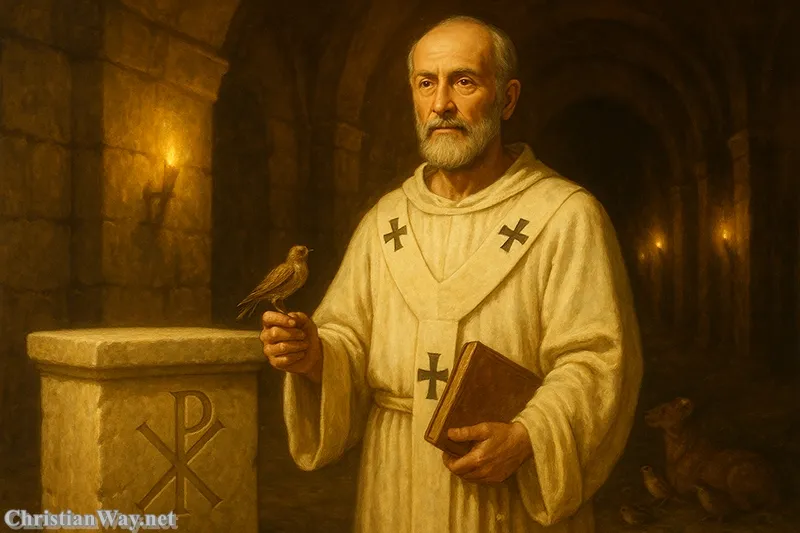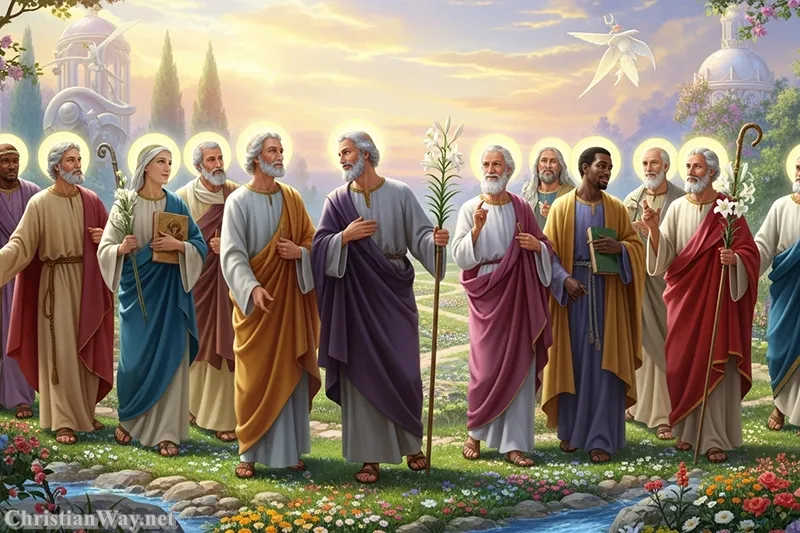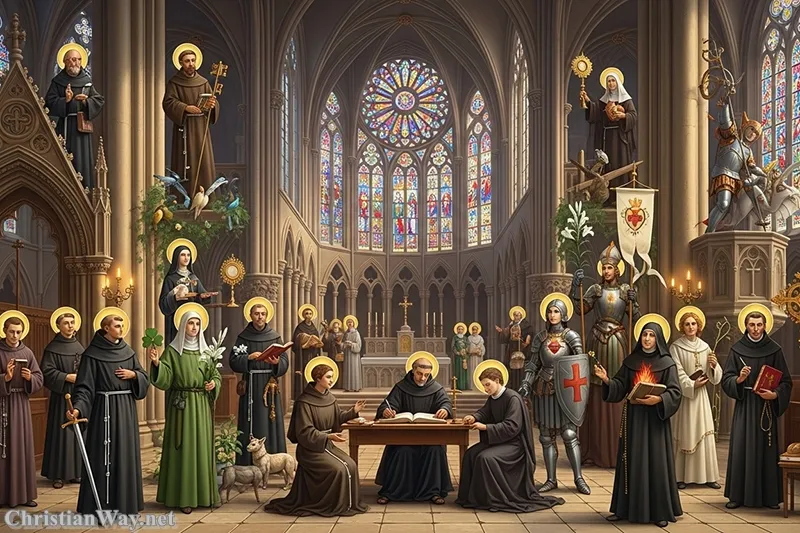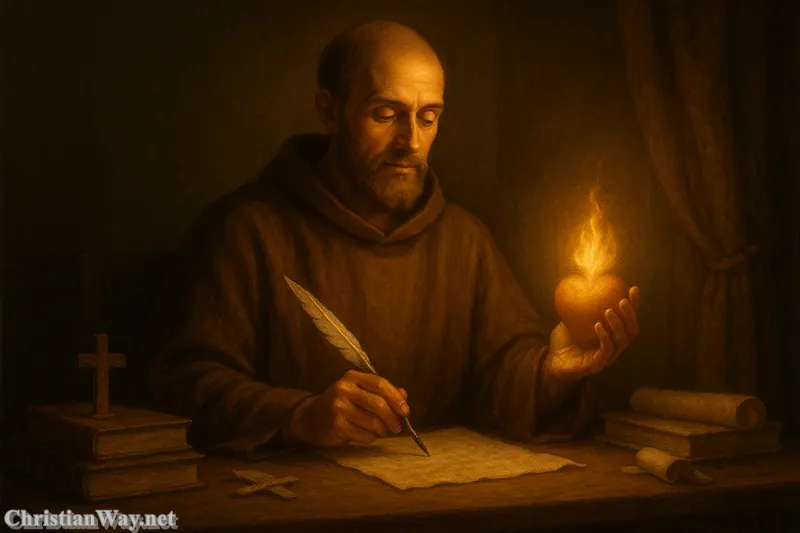Dear friends in Christ,
In every generation, the Church stands upon the faith of those who came before us — men and women who bore the light of Christ through darkness, persecution, and uncertainty. Among these early witnesses, one name often passes quietly through the pages of history: Saint Linus, the first successor of Saint Peter and the second pope of the Catholic Church.

Though little is recorded of his life, his significance is immense. He carried the mantle of leadership after the martyrdom of the Apostle Peter, guiding a fledgling community still trembling under the shadow of Roman power. Saint Linus stands at the threshold between the apostolic and post-apostolic age, a living link in the chain of apostolic succession that connects us, even now, to the time when Christ walked the earth.
Let us pause and walk back through time — to the first century, when faith was new, hope was dangerous, and a man named Linus took up Peter’s cross-shaped torch with steadfast love.
The Early Life of Saint Linus — A Quiet Beginning in the Roman World
According to ancient sources, St Linus was born in Tuscany, Italy, possibly in the city of Volterra. His name, derived from Greek, means “flax,” a symbol of purity and service — fitting for a man whose life would be woven into the fabric of the early Church.
Tradition holds that he may have been converted by Saint Peter himself during the Apostle’s ministry in Rome. When the Christian community was still small and often hidden, Linus became one of Peter’s trusted companions, learning from the fisherman of Galilee the art of spiritual leadership, the endurance of suffering, and the humility of service.
The Scriptures themselves offer a subtle clue to his presence. In 2 Timothy 4:21, Saint Paul writes:
“Eubulus, Pudens, Linus, Claudia, and all the brethren send greetings.”
This brief mention in the New Testament is one of the few historical anchors we have, but it confirms Linus’s participation in the earliest Christian community — the one gathered around Peter and Paul in Rome, where the blood of martyrs would become the seed of the Church.
The First Successor of Saint Peter — The Birth of Apostolic Continuity
A new shepherd for a growing Church
When Saint Peter was martyred under Emperor Nero around the year 64 or 67 A.D., the Church faced a grave challenge: how would leadership continue after the Apostles were gone? The answer came through divine providence and apostolic order.
Linus, who had served faithfully under Peter, was chosen as the first successor of Saint Peter, becoming the second pope of the Catholic Church. This moment marked the beginning of what we now call the papal succession — the unbroken line of bishops of Rome, guardians of the faith and unity of the Church.
As the early popes of the Catholic Church, men like Linus, Cletus, and Clement carried forward not their own ideas, but the teaching of Christ entrusted to them by the Apostles. Linus’s election affirmed that the authority of Peter — the rock upon which Christ built His Church — did not die with him, but continued in those who followed in his place.
The Ministry of Pope Saint Linus — Leading Amid Persecution
Faith in the age of fear
To be Bishop of Rome in those early years was not a position of honor or power, but of danger. Christians were still considered outlaws, often accused of treason, superstition, or even atheism because they refused to worship the Roman gods. The city that had seen Peter and Paul executed was still stained with the memory of their blood.
St Linus led the Church with courage and faith in this hostile environment. Though details are scarce, early Christian writers like Irenaeus of Lyons (in his Against Heresies) and Eusebius of Caesarea (in his Church History) record Linus as the immediate successor of Peter.
He is believed to have continued Peter’s mission: strengthening the faith of believers, organizing the young Christian community in Rome, and preserving the teachings of the Apostles.
According to some traditions, Linus introduced liturgical order into the Church, possibly including rules concerning the role of women in worship and the veiling of women — mentioned by later sources like the Liber Pontificalis. While historical details remain uncertain, such traditions reflect the gradual shaping of Christian life and worship under the guidance of the early popes.
Saint Linus and the Apostolic Fathers
A bridge between the Apostles and the Church Fathers
Saint Linus stands as a bridge figure — between the age of the Apostles and the era of the Church Fathers. He lived close enough to the Apostolic mission to have heard their voices and yet long enough to pass on their wisdom to a Church now expanding throughout the Roman world.
Writers like Saint Irenaeus (2nd century) cherished Linus as part of the unbroken chain of succession, proving that the faith handed down from the Apostles was preserved faithfully by their successors. This idea — apostolic succession — became one of the defining marks of the Catholic Church, safeguarding its unity, doctrine, and authority.
A Martyr for Christ
The witness of blood
Though the historical evidence is not definitive, Church tradition holds that Pope Saint Linus was martyred for the faith, following in the footsteps of Peter and Paul. Some accounts say he was beheaded under the reign of Emperor Domitian, around A.D. 76 or 79, while others suggest he died peacefully after years of persecution.
Whatever the circumstances, his courage remains a testimony to fidelity under trial. The martyrdom of St Linus symbolizes the cost of faith in a world that often rejects truth. Like many of the saints of the early Church, he embraced death not with fear but with hope — the same hope that had conquered Rome through the Cross of Christ.
The Tomb and Relics of Saint Linus
The tomb of St Linus is believed to rest near that of Saint Peter, beneath the ancient Vatican Necropolis. Early Christian inscriptions mention his name among the first bishops of Rome, a sign of the deep veneration held for him by subsequent generations.
Later popes and chroniclers honored Linus as one of the founding shepherds of the Church, whose steadfast faith became the cornerstone of the papacy. In many churches throughout Europe, relics attributed to him are enshrined with devotion, reminding the faithful of the living continuity between the earliest believers and today’s Catholic Church.
The Feast Day of Saint Linus
The St Linus feast day is celebrated on September 23 in the liturgical calendar. Though his life remains shrouded in mystery, the Church honors him not for what he wrote or said, but for what he lived: steadfast obedience to the call of Christ and fidelity to the mission entrusted to Peter.
Each year, on his feast, the Church remembers the humble shepherd who ensured that the voice of the Apostles would not fade, but echo through the centuries.
Saint Linus and the Meaning of Apostolic Succession
Continuity in faith, not in power
Saint Linus reminds us that the papacy is not a human institution built on ambition or wealth but a divine trust of faith and service. The line of popes, stretching from Linus to Francis, represents the spiritual heartbeat of the Church — the living voice of Christ speaking through time.
When we say in the Creed, “We believe in one, holy, catholic, and apostolic Church,” we confess our faith in this very continuity — that what began in the upper room at Pentecost still lives, unbroken, in every Eucharist celebrated today.
Through Linus, the Church learned that the death of an Apostle was not the end of mission but the beginning of legacy.
Lessons from the Life of Saint Linus
1. Humility in leadership
Linus inherited the greatest task imaginable: to follow Saint Peter. Yet he led quietly, without glory or recognition. His life shows that holiness in leadership is not found in visibility, but in fidelity.
2. Faith amid persecution
The Church he guided was small and hunted. Yet Linus did not abandon his flock. He teaches us to stand firm when faith is costly — to lead by love, not by fear.
3. Continuity of truth
In an age of confusion, Linus embodied the stability of truth. His fidelity assures us that Christ’s promise — “The gates of hell shall not prevail against it” — remains true through every century.
4. The hidden saints
Linus’s obscurity is a lesson for every believer who serves quietly, unseen by the world but known by God. Sanctity often wears no crown, save obedience.
Saint Linus in Catholic Tradition
The Catholic saints list places Linus at the very dawn of Church history. While later popes would build basilicas and face councils, Linus’s mission was foundational — preserving the faith of a Church still bleeding from the wounds of its martyrs.
He belongs to the company of early Church saints who remind us that every structure of faith rests upon personal holiness. Without men like Linus, the memory of Peter and Paul might have faded; with him, their message endured.
Artists throughout the centuries have depicted Pope Saint Linus wearing simple papal vestments, sometimes with a martyr’s palm or the keys of Peter, signifying his role as the first successor of Saint Peter.
Faith in the Early Roman Church
The seed of the papacy in the soil of sacrifice
In the first century, the Church in Rome met not in grand basilicas but in homes and catacombs. Each Eucharist was celebrated in secrecy, every bishop chosen under the threat of death. In this crucible, Linus nurtured the seed of the Catholic Church’s hierarchy — not as a system of power, but as a family of faith.
The courage of Linus and his fellow believers gave rise to the living body we now call the Church. Every pope since has walked, in spirit, through the same shadowed catacombs — carrying the same torch of truth lit by Peter, handed to Linus, and passed through generations.
Saint Linus and Modern Faith
Even today, Saint Linus speaks to our modern hearts. His life calls us to fidelity in a world of distraction, to humility in an age of self-promotion, and to unity in times of division.
He reminds us that the Church is not sustained by human wisdom but by divine promise. And that promise — spoken by Christ to Peter — lives in the unbroken chain of successors, from Linus to the present Holy Father.
🕯️ Reflect and Pray
Lord Jesus Christ,
You built Your Church upon the faith of the Apostles and sustained it through their successors.
We thank You for Saint Linus, the faithful shepherd who carried Peter’s mission with humility and courage.
Grant that we, too, may remain steadfast in truth, gentle in service, and joyful in faith.
May his example inspire in us fidelity to the Gospel, love for the Church,
and unity with all who follow You in every age.
Through Christ our Lord. Amen.
May the humble strength of Saint Linus guard your faith and remind you that holiness often works quietly, holding the Church together with invisible grace.
— Fr. John Matthew, for Christian Way











